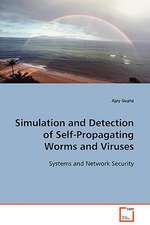Programs as Diagrams: From Categorical Computability to Computable Categories: Theory and Applications of Computability
Autor Dusko Pavlovicen Limba Engleză Hardback – 20 sep 2023
In this unique textbook/reference, programs are drawn as string diagrams in the language of categories, which display a universal syntax of mathematics (Computer scientists use them to analyze the program semantics; programmers to display the syntax of computations). Here, the string-diagrammatic depictions of computations are construed as programs in a single-instruction programming language. Such programs as diagrams show how functions are packed in boxes and tied by strings. Readers familiar with categories will learn about the foundations of computability; readers familiar with computability gain access to category theory. Additionally, readers familiar with both are offered many opportunities to improve the approach.
Topics and features:
- Delivers a ‘crash’ diagram-based course in theory of computation
- Uses single-instruction diagrammatic programming language
- Offers a practical introduction into categories and string diagrams as computational tools
- Reveals how computability is programmability, rather than an ‘ether’ permeating computers
- Provides a categorical model of intensional computation is unique up to isomorphism
- Serves as a stepping stone into research of computable categories
Dusko Pavlovic is a professor at the Department of Information and Computer Sciences at the University of Hawaii at Manoa, and by courtesy at the Department of Mathematics and the College of Engineering. He completed this book as an Excellence Professor at Radboud University in Nijmegen, The Netherlands.
Preț: 593.66 lei
Preț vechi: 742.08 lei
-20% Nou
Puncte Express: 890
Preț estimativ în valută:
113.59€ • 118.92$ • 93.99£
113.59€ • 118.92$ • 93.99£
Carte tipărită la comandă
Livrare economică 05-19 aprilie
Preluare comenzi: 021 569.72.76
Specificații
ISBN-13: 9783031348266
ISBN-10: 3031348265
Ilustrații: XVII, 252 p. 1 illus.
Dimensiuni: 155 x 235 mm
Greutate: 0.56 kg
Ediția:1st ed. 2023
Editura: Springer Nature Switzerland
Colecția Springer
Seria Theory and Applications of Computability
Locul publicării:Cham, Switzerland
ISBN-10: 3031348265
Ilustrații: XVII, 252 p. 1 illus.
Dimensiuni: 155 x 235 mm
Greutate: 0.56 kg
Ediția:1st ed. 2023
Editura: Springer Nature Switzerland
Colecția Springer
Seria Theory and Applications of Computability
Locul publicării:Cham, Switzerland
Cuprins
1. Drawing Types and Functions.- 2. Monoidal Computer: Computability as a Structure.- 3. Fixpoints.- 4. What can be Computed.- 5. What cannot be Computed.- 6. Computing Programs.- 7. Program-Closed Categories: Computability as a Property.- 8. Computable Categories and Effective Categorical Operations.
Notă biografică
Dusko Pavlovic was born in Sarajevo, studied mathematics and programming in Utrecht, taught at McGill, Imperial College London, Oxford, and Royal Holloway, before joining University of Hawaii in 2014. In the meantime he also spent 12 years thinking and talking about applications in Palo Alto CA. His research interests evolved from pure mathematics, through theoretical computer science and software engineering, to network computation and security, with excursions into quantum computation and game theory. He authored more than 100 refereed publications. In his ample spare time he enjoys providing strategic advice to his 3 children and writing about himself in third person.
Textul de pe ultima copertă
It is not always clear what computer programs mean in the various languages in which they can be written, yet a picture can be worth 1000 words, a diagram 1000 instructions.
In this unique textbook/reference, programs are drawn as string diagrams in the language of categories, which display a universal syntax of mathematics (Computer scientists use them to analyze the program semantics; programmers to display the syntax of computations). Here, the string-diagrammatic depictions of computations are construed as programs in a single-instruction programming language. Such programs as diagrams show how functions are packed in boxes and tied by strings. Readers familiar with categories will learn about the foundations of computability; readers familiar with computability gain access to category theory. Additionally, readers familiar with both are offered many opportunities to improve the approach.
Topics and features:
Dusko Pavlovic is a professor at the Department of Information and Computer Sciences at the University of Hawaii at Manoa, and by courtesy at the Department of Mathematics and the College of Engineering. He completed this book as an Excellence Professor at Radboud University in Nijmegen, The Netherlands.
In this unique textbook/reference, programs are drawn as string diagrams in the language of categories, which display a universal syntax of mathematics (Computer scientists use them to analyze the program semantics; programmers to display the syntax of computations). Here, the string-diagrammatic depictions of computations are construed as programs in a single-instruction programming language. Such programs as diagrams show how functions are packed in boxes and tied by strings. Readers familiar with categories will learn about the foundations of computability; readers familiar with computability gain access to category theory. Additionally, readers familiar with both are offered many opportunities to improve the approach.
Topics and features:
- Delivers a ‘crash’ diagram-based course in theory of computation
- Uses single-instruction diagrammatic programming language
- Offers a practical introduction into categories and string diagrams as computational tools
- Reveals how computability is programmability, rather than an ‘ether’ permeating computers
- Provides a categorical model of intensional computation is unique up to isomorphism
- Serves as a stepping stone into research of computable categories
Dusko Pavlovic is a professor at the Department of Information and Computer Sciences at the University of Hawaii at Manoa, and by courtesy at the Department of Mathematics and the College of Engineering. He completed this book as an Excellence Professor at Radboud University in Nijmegen, The Netherlands.
Caracteristici
Provides a diagrammatic programming language, based on and supporting the geometric algorithmic intuitions Guided exercises (workouts) soften the demarcation line between passive and active use of the book Categorical approach opens a device-independent view of computation


























